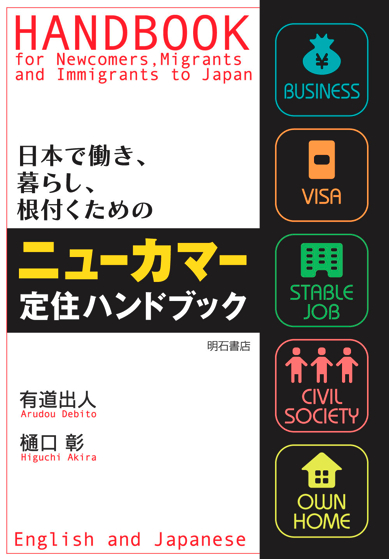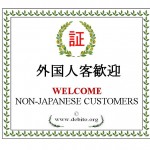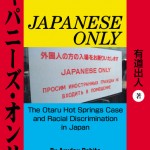mytest






Hi Blog. Another nice review of HANDBOOK this time from Tanya Clark (niece of Japan Times columnist Gregory Clark, BTW). See other reviews (including the Japan Times, the Daily Yomiuri, etc.) here. FYI. Thanks Tanya. Debito
==================================
WEDNESDAY, SEPTEMBER 24, 2008
Handbook for Newcomers, Migrants and Immigrants to Japan – A Review
Courtesy http://www.tanya-clark.com/2008/09/handbook-for-newcomers-migrants-and.html
BI (Before the Internet) I, and anyone with more than a passing interest in Japan, would have to scour bookstores and libraries looking for clues as to how to navigate our way through life in Japan. New publications would elicit [internal] squeals of glee – even if closer examination would, all too often, lead one to suspect the author may have only travelled from Narita Airport to Roppongi [the area of Tokyo where foreigners tend to congregate] — and gone no further. At least, perhaps, I would silently hope, some glimmer of useful, new fact would find its way through the dross to help inform the daily challenges of life in Japan. And, on those rare occasions, a real jewel revealed itself, the joy was genuine.
Post internet, of course, research into life in Japan is so much easier. But, it is not all that straightforward. The language challenge remains. And while many of the more basic details (how to get a tourist or working holiday visa, how to find a hotel etc.) are fairly well documented; the deeper details are not. The nitty gritty of a life lived in Japan is barely revealed.
So, it was with my [mental] fingers tightly crossed that I first opened Arudou and Higuchi’s book. I have interacted with Arudou off and on over the years as his editor and as someone who paid passing attention to his activities as a Japan-based activist for foreigners’ rights. Arudou had taken the challenging path of adopting Japanese nationality (he was an American citizen) and creating a life for himself in Hokkaido, itself a frontier-esque northern island in Japan. Knowing Arudou knew his subject had raised my hopes. But, he and his writing partner pulled it off?
Indeed they had. The two of them (Higuchi is a Hokkaido-based lawyer) had summarised the nuts and bolts of life for people whose Japan stay is extended. Whether it is maintaining a funeral plot in Japan, buying a car, joining a union or tips on divorcing a troublesome partner — life’s essential tips and tricks are covered.
Their approach is straightforward. The brass tacks of a life lived anywhere have some pretty common themes — and they adopt these as the core chapter topics.
· Arriving and establishing a home
· Stabilizing employment and lifestyles
· Starting a business
· What to do if…(life, work, court, family)
· Retirement and planning for the future
· Giving something back
The book is written in English and Japanese, the Japanese text is on the obverse and English on the verso. The English used is not grammatically complicated (a deliberate move by the authors to allow for easier access to readers whose English is a second language) but not so simplistic as to annoy your average English speaker. The Japanese text adopts a similar approach.
Should you be curious, the first three chapters were written by Higuchi and the others by Arudou.
There is a Japanese-ness to the layout and structure, even to the tone, of the Handbook. Their approach is sparse, grey; a touch bureaucratic. Each topic is broached directly, then broken down into its core elements; explained and ticked off; as the authors rapidly move on to the next huge life issue. This helps to create an easy to read and accessible volume; despite the breadth and depth of their goal.
A typical example of this approach would be their coverage of Japan’s salary system.
Now let’s talk about how people get paid in Japan. As the Labor Standard Law only requires payment of salary (kyuuryou 給料, rendered as kyuuyo 給与 on documents) at least once a month, most companies pay once a month (usually on the 25th); few companies pay fortnightly.
The next paragraph breaks down the contents of a typical pay check, the next discusses the biannual bonus system. After that they examine deductions and taxes and then look at the different insurances covering workers in Japan.
The authors make no commitment to provide an exhaustive fount of information on any one topic. Their goal was to create a concise and affordable reference book to help people find information efficiently. And they do so. Where possible, they provide information on additional sources (including websites). The section on the salary system concludes with links to four useful English language resources.
One key difference between this book and nearly everything else out there is that the authors assume their readers are looking to make a permanent life in Japan.
Most guides to living in Japan, rightly or wrongly, tend to focus on life as a foreigner, as someone who only plans to be living in that country for a set period of time (even if it is ten years).
Arudou and Higuchi write for an audience that views its move to Japan as permanent (even if it is for ten years).
This is a big theme in terms of Japan’s relations with its foreign residents. Personally, I would argue Japan is one of the few developed countries that does not try particularly hard to assimilate foreigners into its society. There are others who would agree.
Arudou has been particular active in this arena; seeking to bring Japan’s attention to some of the more exclusionary practices he has come across. [See Arudou Debito, Japanese Only–The OtaruOnsen Refusals and Racial Discrimination in Japan, Akashi Shoten: 2006.]
The authors’ approach confronts some time-honoured “Japan’s myths” as well. In the coverage on ‘Going to Court’ they write:
Japan is thought of as a “non-litigious” society, where going to court is viewed as “un-Japanese”. We do not agree. In 1998 alone, according to the Prime Minister’s Office, there were 5,454,942 court cases in all levels of Japan’s justice system. … People in Japan do sue. We recommend that readers view the Japanese judiciary system as just one more alternative for conflict resolution. The Japanese courts exist for a reason. Use them.
The authors are also realistic.
…taking things to court is risky. There is no trial by jury in Japan … so one or three judges will decide your case over several years. If you can wait and have patience and money … then go to court.
Intentionally or otherwise, these excerpts sum up life in Japan all too well. Yes, living in Japan is just like living in most other places (pretty much) — but there is a twist. This Handbook is an excellent guide to set you on the way to learning all those twists (and a few turns).
In brief, Arudou and Higuchi have put together an essential handbook covering the key topics and questions anyone living in Japan (or intending to) needs to address.